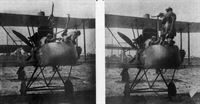Фотографии
-
Регистрационный номер: A6516 [6] A study of A6516 in flight, displaying the distinctive twin-boom layout of the F.E.2d, with the observer perched out in the front where he had a clear field of fire forwards. The 250 h.p. Rolls-Royce engine drove a large, four-bladed propeller, and the boss and one blade from A6516 is now displayed in the RAF Museum. On bombing raids eight 25lb Cooper bombs were carried on the underwing racks visible in this picture. The target had to be overflown twice - once to set the bomb sight and again to release the bombs. Both day and nighttime patrols were flown.
Самолёты на фотографии: RAF F.E.2 - Великобритания - 1914
-
Регистрационный номер: A6516 [6] Capt “Inky” Stevens and W. C. Cambray in their aeroplane, A6516 was a presentation aircraft, bearing the legend “Presented By The Colony of Mauritius No 13” on its nacelle. In the side view the faired pylon for the tailplane bracing is conspicuous
Самолёты на фотографии: RAF F.E.2 - Великобритания - 1914
-
Регистрационный номер: A6516 [6] The overwing gravity petrol tank can be seen, as well as the radiator immediately behind the pilot. The F.E.2d cost about £2,970, had an operational ceiling of 17,500ft, an endurance of 3 1/4 hr, and a speed of 90 m.p.h. at 10,000ft. It could reach 180 m.p.h. in a “power dive”.
Самолёты на фотографии: RAF F.E.2 - Великобритания - 1914
-
Регистрационный номер: A6516 [6] Capt “Inky” Stevens (left) and W. C. Cambray with A6516. In flight the two communicated by sign language, which was developed to a great art. Cambray described Stevens, an Irishman, as a "truly great pilot". Note the generous armament of three Lewis guns, one fixed to fire forward, one on a pivoted forward mounting, and another on a pillar behind the observer’s seat to enable the tail to be defended. The bomb sight can be seen at the side of the pilot’s cockpit.
Самолёты на фотографии: RAF F.E.2 - Великобритания - 1914
-
Регистрационный номер: A6516 [6] Preparing for take-off and waiting for two men to swing the propeller. The aerial camera on the port side is clearly visible. On their last flight, Stevens and Cambray had a dog fight with some “huns” but managed to return to their aerodrome, where the F.E. was found to be “completely unserviceable”. A6516 was built by Boulton & Paul Ltd. at Norwich.
Самолёты на фотографии: RAF F.E.2 - Великобритания - 1914
-
Регистрационный номер: A6516 [6] Left: W. C. Cambray demonstrates the position adopted for taking aerial photographs. The cameras used 6in, 8in, and 15in focal lens with a yellow filter behind them. The top box housed 18 5in x 4in glass plate negatives, and a photo was taken by pressing the plunger. The exposed plate was then moved to bottom box by moving a lever.
Right: The perilous position adopted when using the pillar-mounted gun to defend the tail, while the pilot did his best to outmanoeuvre the enemy. One in three of the 1,000 rounds of ammunition was a tracer bullet. It was common practice for F.E.2ds to fly in circles when attacked in order to provide mutual protection. Without any oxygen, the feat of moving from one gun to another at altitude demanded a great deal of effort from the observer.Самолёты на фотографии: RAF F.E.2 - Великобритания - 1914
Статьи
- -
- Loening OA-1A /Preservation Profile/ (63)
- News Spotlight
- Painted Wings
- Personal album
- A.Jackson - Avro 504N /RAF Piston Trainers/ (2)
- A.Ord-Hume - Wee Mite /British pre-war ultralights/
- H.Levy - Quickie
- H.Levy - Whispering Jetwing
- P.Birtles - Chinese Tridents
- R.Lindsay - De Havilland Venom, part 2 /Fighters of the fifties/ (19)
- R.Sturtivant - FAA Avengers at war (1)
- T.Jones - Aquila Airways
- V.Hodgkinson - Steam Pigeon postsript





